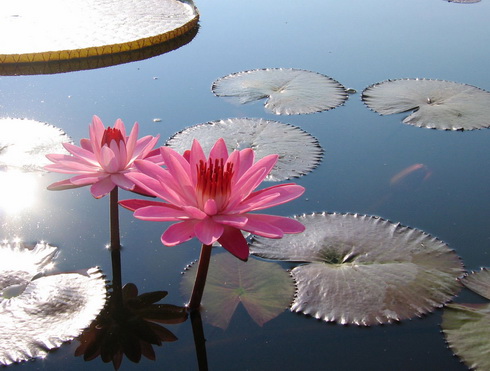|

Water plants
Decoration of a garden reservoir by water and coastal plants has its own specificity. On the one hand, all of them should be decorative and interesting since spring till late autumn, thus whenever possible not to cause efforts in taking care of them, to look good in composition with surrounding garden plants and to correspond the sizes of the reservoir. On the other hand, the plants which we will place in the reservoir, should make their practical functions to clear water, to absorb the surpluses of the dissolved organic chemistry, to sate the water with oxygen, to serve as food and a shelter for inhabitants of water area.
How to observe the harmony
Water plants should always correspond the style of the reservoir, to correspond the general plan and not contradict the common sense. For example, cactuses and succulents, steppe and semidesertic cereals do not grow in the nature on the coast of the reservoirs, that is why some plants have no sense when you see them near reservoirs. Anyway, classical garden plants including roses, are quite pertinent on the bank of a landscape garden reservoir if they are organically entered in the general composition, do not suppress surrounding "simple" plants, and the most important thing is: they do not have to break the harmonious restraint inherent of the paints of water elements.
Quite often there is a situation when the reservoir is executed irreproachably, it effectively enters in the general outline, but without any harmony. It happens, when we do not reflect what to plant directly in water and how to place those or other plants near to a pond or a stream. Too large curtains on the bank or unreasoned landings near the reservoir are able to reduce its visual size. And on the contrary, medium-sized, with the thin leaves, gracefully bent coastal plants, with skill chosen water-lilies will favorably underline smooth lines of coast, without closing the smooth surface of the water.
Therefore, first, it is necessary to consider the degree of growth of plants. Secondly, to define focus points. If the aqua - garden has only one part of review the largest, crank plants have to be on the opposite side. And if the reservoir has to be looked through well from different directions, it is necessary to distribute plants groups, leaving the sufficient part of the coastal line opened, only filling it up with gravel or tightening it with very low, creeping plants.
How to Use Containers ?
Often, using for landing of water plants special mesh or any other plastic containers, we absolutely forget that they are very visible in the water...
Continue of the article: How to Use Containers ?
If the Reservoir is not Big
If the garden reservoir has not so big sizes, the area of its water surface is insignificant, try to use for landing not specific plants, but grades and garden forms...
Continue of the article: If the Reservoir is not Big
Decorating the Coastal Zone
Many plants which in nature live in damp and even the rehumidified places, along the banks of small rivers, streams and in dams, during warm time can very well live immersed in water on depth of 5 - 20 cm, but will winter better on dry soils...
Continue of the article: Decorating the Coastal Zone
Taking Care of your Reservoir
In order to take care of your reservoir and water plants it is necessary to have special pond scissors or secateurs, nippers and a net on long sliding, bars...
Continue of the article: Taking Care of your Reservoir
About Water Fauna
For the health of your reservoir are vital not only plants, but also living creatures: small fishes, green pond frogs, tritons, predatory water bugs and mollusks...
Continue of the article: About Water Fauna
|
